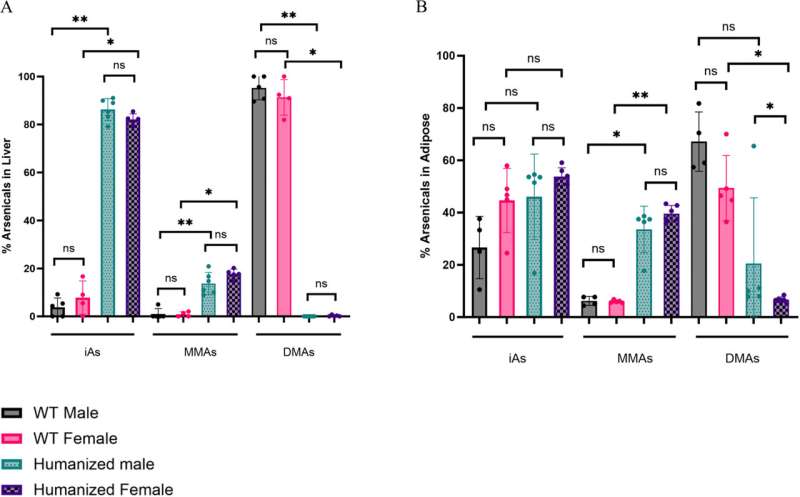This article has been reviewed according to Science X's editorial process and policies. Editors have highlighted the following attributes while ensuring the content's credibility:
fact-checked
peer-reviewed publication
trusted source
proofread
Humanized mice reveal arsenic may raise diabetes risk only for males

Chronic exposure to arsenic, often through contaminated groundwater, has been associated with type 2 diabetes in humans, and there are new clues that males may be more susceptible to the disease when exposed.
A new study—using lab mice genetically modified with a human gene to shed light on the potential link—revealed that while the male mice exposed to arsenic in drinking water developed diabetes, the female mice did not.
These results would not have been possible without using a mouse model engineered to express a human enzyme for metabolizing arsenic, since normal mice process arsenic much more efficiently than humans and require very high levels of exposure before they become diabetic.
In the paper, the researchers also identified a transcription factor called Klf11, which might be the master regulator of the difference in how the livers of males and females respond to arsenic.
"Our paper lays the foundation for future investigations into the mechanism of how arsenic exposure leads to diabetes, why there are striking male-female differences and potential therapeutic strategies," said Praveen Sethupathy '03, professor of physiological genomics and chair of the Department of Biomedical Sciences at the College of Veterinary Medicine, and the study's senior author.
"It highlights how important it is to use an appropriate genetic model [in this case, humanized mice], because none of these results were seen in the wild-type mice," said Jenna Todero, a doctoral student in Sethupathy's lab.
Todero is the first author of "Molecular and Metabolic Analysis of Arsenic-exposed Humanized Arsenic +3 Methyl Transferase (AS3MT) Mice," which published in the journal Environmental Health Perspectives.
Arsenic is the top priority substance for study, according to the Agency for Toxic Substances and Disease Registry. Human exposure to arsenic, which is common in the environment, often comes through contaminated groundwater. According to the World Health Organization and the Environmental Protection Agency, the safe exposure limit is ten parts per billion.
Endemic levels of arsenic above safe limits in both Bangladesh and Mexico led to studies that showed an association between higher levels of arsenic exposure and type 2 diabetes. Though these studies had very small sample sizes, they offered clues for further research.
The current study was performed on regular lab mice—known as wild-type mice—as a control and humanized mice that were engineered to express a human form of an enzyme, AS3MT, which is found across species and is important for metabolizing arsenic in the body. The efficiency of this enzyme differs across species, but mice are far faster than humans at metabolizing arsenic.
All the mice were exposed for a month to doses of arsenic in drinking water that were nonlethal but sufficient to promote type 2 diabetes potentially. The researchers then examined liver and white adipose tissues that are implicated in diabetes. In the humanized male mice alone, they found increased gene expression related to insulin resistance. Also, in the humanized male mice's liver and white adipose tissues, they identified a biomarker called miR-34a, which is highly associated with insulin resistance in type 2 diabetes and other metabolic diseases.
"This would suggest miR-34a is potentially a way to screen individuals who live in areas with endemic arsenic levels," Todero said. "If you have elevated miRNA-34a, you might be at risk for type 2 diabetes onset or other metabolic dysfunction."
The researchers also identified the transcription factor (which regulates genes) Klf11 in the liver. "This was really exciting because we showed that genes that are highly important for things like regulating glucose or lipid metabolism seem to be targets for Klf11," Todero said.
They found that Klf11 was significantly turned down in the humanized males but not in the wild-type mice or the females. The study's authors speculate that Klf11 might be a master regulator for genes associated with energy usage. It was suppressed in humanized male mice, likely causing dysregulation and hallmarks of diabetes, such as insulin resistance and elevated fasting blood glucose.
In the female humanized mice, the researchers found evidence of elevated expression of genes that support insulin sensitivity.
"We saw the opposite effect in females, where genes that promoted insulin sensitivity and glucose uptake had increased expression," Todero said. Previous work by another group suggested that the female sex hormone estradiol may play a role in the sexual divergence in the association between arsenic and type 2 diabetes.
More information: Jenna Todero et al, Molecular and Metabolic Analysis of Arsenic-Exposed Humanized AS3MT Mice, Environmental Health Perspectives (2023). DOI: 10.1289/EHP12785





















